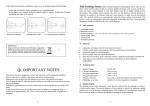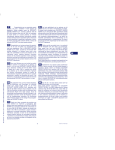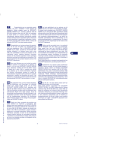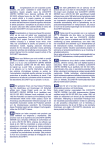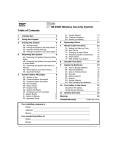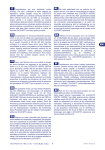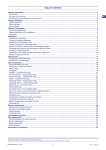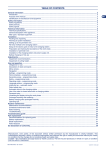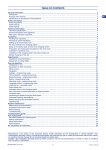Download 1 SUMMARY General Information
Transcript
SUMMARY General Information....................................................................................... 1 Installation of charging station ..................................................................... 2 Installation of perimeter wire ........................................................................ 6 Start up .......................................................................................................... 7 GENERAL INFORMATION EN Important This manual is an addition to the user manual of the robot. This robot, if equipped with a docking (charging) station, can operation in two different modes based on the installation and configuration of the robot. The standard operation, without changing the configuration, is described in the user manual. The robot operates inside the mowing area detected by drop-off and grass sensors. On completion of the work cycle, the robot runs along the mowing area until it encounters the guide wire. It then follows this wire until it reaches the charging station. This operating method is very fast and easy to install, however, there may be some passages with no grass between one area and another, or where the quality of the lawn does not conform to the robot specifications. MD-CT-RO-01-ADDITION - XX - REV 3.3- EN - 10-2011 - (L50EEU) In cases where the mowing area does not conform to the specifications, the robot can be configured to operate with the drop-off and grass sensors turned off. In this case, the mowing area must be marked by the perimeter wire. The purpose of this integrative manual is to describe the installation and use of the robot with the perimeter wire marking the outside boundary of the mowing area and all the objects inside that must be excluded so that the robot can operate correctly. 1 User’s manual INSTALLATION OF CHARGING STATION Install the charging station by following the instructions described in the “INSTALLATION OF CHARGING STATION” chapter of the user manual, except for the laying of the guide wire whose function is performed by the perimeter wire described below. SETTING UP OF THE PERIMETER WIRE Before installing the perimeter wire, it is necessary to check the entire surface of the lawn. Assess whether modifications or adjustments need to be made to the grassy surface during the laying of the perimeter wire in order to allow the robot to operate properly. • Proceed with the “Preparation and defining of the work areas”. • Installation of the perimeter wire. When laying the perimeter wire, respect the installation direction (clockwise) and the rotation direction around the flowerbeds (anti-clockwise). As shown in the figure. • Installation of the charging station and power supply-transmitter unit. PREPARATION AND DEFINING OF THE WORK AREAS Preparation of the lawn to be mowed 1. Make sure the lawn to be mowed is even and does not contain holes, stones or other obstacles. If necessary, prepare the lawn by filling in any holes and removing any obstacles. If some obstacles cannot be removed, it is necessary to properly define them with the perimeter wire. User’s manual HOLES EN 2 NO 2. Check that no areas of the lawn exceed the allowable slopes (see “Technical Specifications”. In the presence of slopes, the wheels may slip when the robot detects the perimeter wire, causing it to fall outside the perimeter. The maximum slope that the robot can mow on the conditions of the grassy surface, the type of lawn and the humidity present in the mowing area. In case of boundary conditions, it is recommended to have the conditions assessed by a technician. NO 40 % 40 cm (15,75 Inc.) 100 cm (39,3 Inc.) 0-40% 0-30% 31-40% NO OK perimeter wire 31-40% 35 cm NO 13,78 Inc. Important Areas with slopes greater than those specified cannot be mowed with the robot. Therefore, position the perimeter wire in front of the slope so that it is excluded from the mowing area. Defining the boundary of work area. 5 cm 1,97 inc. 3. Check the whole surface of the lawn. To make installation of the perimeter wire easier, check the entire path. The illustration shows a lawn with the track for burying the perimeter wire. During installation of the system, any narrow passages must be identified. A narrow passage is a section of lawn connected to the main lawn with a path that is narrower than 150 cm / 59.05 inches and difficult to reach by the robot. In these cases, there is no guarantee that the robot can reach this area on its own; therefore, it may be necessary to bring the robot by hand to this area or to exclude it from the installation. 70 cm 5 cm 27,56 inc. 1,97 inc. 70 cm 27,56 inc. 5 cm 5 cm 1,97 inc. 1,97 inc. 4-10 mt. 157,5 - 393,7 inc. 5 cm 1,97 inc. 35 cm 2 mt. 13,78 inc. 78,75 inc. 35 cm 13,78 inc. 35 cm 13,78 inc. 35 cm 35 cm 13,78 inc. 13,78 inc. 35 cm 13,78 inc. drain cover 4. Define the boundaries and trace the perimeters of the elements inside and on the border of the work area that obstruct the correct functioning of the robot. 35 cm 13,78 inc. 35 cm flowerbed 3 13,78 inc. User’s manual EN Important The illustration shows an example of the elements inside and on the perimeter of the work area and the distances to follow for the correct laying of the perimeter wire. Define the boundary of all iron or metal elements (drain covers, electric connections, etc.) to prevent interferences with the signal of the perimeter wire. EN 35 cm wall 13,78 inc. shower plate 35 cm 70 cm 13,78 inc. 27,56 inc. 35 cm 13,78 inc. 35 cm 13,78 inc. protruding roots Do not delimit obstacles (trees, poles, etc.) which do not obstruct the normal operation of the robot. These generally include obstacles that can withstand being hit by the robot, such as a plant, pole, wall, etc. However, obstacles such as a plant with protruding roots, flowerbeds, small plants, etc. must be delimited. OK User’s manual OK plant 4 pole 5. Delimit any areas below the surface level of the lawn (pools, areas with significant drops, stairs, etc.) (see the figure). 70 cm 27,56 inc. - With Pool, Steps, Drops: 70 cm (27.56 in.) a danger point for the robot. 70 cm 27,56 inc. EN Important Carefully follow the distances in order to prevent the robot from falling and breaking and/or being irreversibly damaged. Increase the distance by at least 30 cm/11.81 inches in the presence of slopes or slippery ground. 6. Delimit the perimeters as shown in the figure. - With paths at the same height as the lawn: 5 cm (1.96 in.) - With paths higher than the lawn: 35 cm (13.78 in.) 35 cm 13,78 inc. - With the presence of an enclosing wall: 35 cm (13.78 in.) 35 cm 13,78 inc. 5 cm 1,97 inc. 7. Before the charging station, install the “Recall on the Wire.”This operation requires a special installation of the perimeter wire in the section in front of the charging station, as shown in the figure. When returning to the charging station, the robot will run along the perimeter wire, touching it every now and again in a rebound movement, until it recognises the “Recall” to the charging station. The robot will follow the perimeter wire in a more precise way for around 10 meters (33 feet) until it encounters the charging station. 5 cm 1,97 inc. 70 cm 27,56 inc. 5 cm 1,97 inc. 70 cm 27,56 inc. 5 cm 1,97 inc. 4-10 mt. 5 cm 1,97 inc. 157,5 - 393,7 inc. 5 cm 1,97 inc. 35 cm 2 mt. 13,78 inc. 78,75 inc. 35 cm 13,78 inc. 35 cm 13,78 inc. 35 cm 35 cm 13,78 inc. 13,78 inc. 35 cm 13,78 inc. 5 User’s manual The “Recall on the wire” not only signals to the robot that it is near the charging station, but also if there is a narrow passage. As soon as a “Recall” is recognised, the robot will follow the perimeter wire at low speed, and with more precision for around 10 meters (33 feet). It will then return to bouncing off the wire. Follow these instructions to install the “Recall.” • The “Recall” is a piece of wire that extends for around 2 m (6.6 ft.) with a distance of 5 cm (1.96 in.) between each wire. • The “Recall” must be positioned at a distance of 4 and 10 m. (13.2 - 33 ft.) before the charging the station. EN • The “Recall” must be positioned in the section before any narrow passages that are less than 2 meters (6.6 feet) long. 8. Connect the perimeter wire to the charging station as indicated in the chapter “INSTALLATION OF CHARGING STATION” of the user manual. INSTALLATION OF PERIMENTER WIRE The perimeter wire can be buried or laid on the ground. perimeter wire Important Start laying the perimeter wire from the installation zone of the charging station and leave a couple of extra meters, so that it can then be cut down to size when connecting to the power unit. Max. 5 cm (1,96 inc.) Ground wire 1. Position the wire, in a counter clockwise direction, along the whole track and secure it with the pegs supplied (distance between each peg of 100÷200 cm (39.37÷78.74 in.)). NO – When laying the perimeter wire, follow the installation direction around the flowerbeds (anti-clockwise). – In straight sections, secure the wire so that it is not too taut, wavy and/ or twisted. wire fastening pegs – In curved sections, secure the wire so that it is not twisted, but curves nicely. User’s manual 6 perimeter wire Buried wire 1. Dig the ground in a regular and symmetrical manner with respect to the line traced on the ground. 2. Position the wire in an anti-clockwise direction along the track a couple of centimetres deep (around 2÷3 cm (0.7874÷ 1.1811 in.)) so that the quality and intensity of the signal received by the robot is not reduced. 3. During the laying of the wire, it may be necessary to secure it in some parts with special pegs to hold it in position when covering with dirt. 4. Cover all the wire with the soil and make sure it does not twist, but remains straight and that the curved sections are neat and tidy. EN Important In sections where it is necessary to pass two parallel wires (e.g. to delimit a flowerbed), make sure they are laid on top of each other at a minimum distance of 1 cm. (0.40 in.) NO Max 1 cm (0,40 inc.) START UP On first use, the robot must be configured to operate with the outside perimeter. This only has to be done once. After which, this configuration will remain even if the robot is turned off. Press “ON” to turn on the robot and keep it pressed for about 4-5 seconds until the “ON” and “PAUSE” leds start flashing alternatively. Release the “ON” key while only the “PAUSE” led is flashing. PAUSE LOW BATTERY START STOP PAUSE LOW BATTERY START STOP PAUSE LOW BATTERY HIGH BATTERY ON 7 OFF ON HIGH BATTERY ON OFF ON HIGH BATTERY ON OFF ON START STOP 4 sec. User’s manual Important If this operation was done by mistake, return to the standard configuration by following this operation. Press “ON” to turn on the robot and keep it pressed for about 4-5 seconds until the “ON” and “PAUSE” leds start flashing alternatively. Release the “ON” key while the “ON” led is flashing. At this point, the robot can be started as described in the “START UP. ROBOT WITH CHARGING STATION” section of the user manual. EN User’s manual 8








